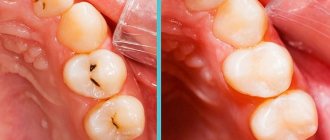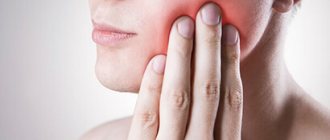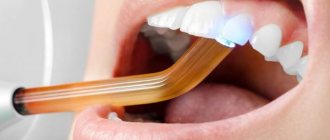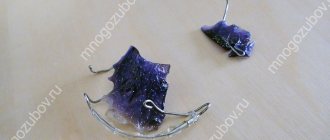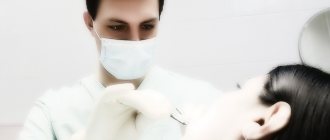Author: Brodsky Sergey Evgenievich Deputy Chief Physician, Candidate of Medical Sciences in the specialties: dentistry and medical microbiology Some people notice that a filled tooth reacts to cold and hot, but they cannot understand the reason that provoked the appearance of such symptoms. The reaction of the tooth to the temperature of the food consumed is called hyperesthesia in medicine. This negative phenomenon, characterized by the occurrence of unpleasant sensations in the dentition after cold and hot temperatures, is quite widespread and significantly reduces a person’s quality of life.
Deputy Chief physician Sergey Evgenievich Brodsky
Sign up for a free consultation
+7
Causes of hyperesthesia
A tooth can hurt from cold or hot temperatures for various reasons. A natural factor is the thinning of the enamel, which protects the tooth from the aggressive influence of the external environment. Beneath it there is dentin, which is in direct contact with the nerve endings that penetrate the pulp, which is why teeth hurt after drinking cold water or eating hot food.
Such a non-dental cause of a negative phenomenon, such as thinning of tooth enamel, which provokes increased sensitivity of the tooth, can arise under the influence of the following factors:
- bruxism;
- toxicosis during pregnancy;
- pathologies of the endocrine system;
- infectious or viral lesions;
- lack of minerals, calcium or phosphorus;
- exposure of the tooth to chemicals contained in air or water.
Prevention
Teeth hurt from temperature changes (cold and hot), but this does not mean that in order to prevent the problem, any external influence should be limited as much as possible. The modern market offers many pastes, gels, ready-made rinses and other compositions that can prevent the appearance of an unpleasant symptom or suppress it at the earliest stages. Since the composition of all products is different, doctors advise changing them periodically. In this case, it is better to exclude special bleaching agents altogether.
There are also general rules, if followed, you can protect yourself from the occurrence of hypersensitivity:
- High-quality oral hygiene. Cleaning is carried out at least 2 times a day, morning and evening. After eating, you should rinse your mouth and use floss.
- Nutrition is adjusted, it must be balanced. It is important that the foods you eat contain sufficient amounts of minerals, vitamins and other valuable components. It is recommended to limit the consumption of sweets, hard nuts and seeds, and soda as much as possible.
- Consult your doctor about possible intake of vitamin-mineral complexes.
- You should visit the dentist 2 times a year. Even if nothing bothers a person, the doctor is able to diagnose the disease at its very beginning.
What should you do if your tooth feels cold and hot, or is swollen by the breath of a chilly autumn wind or a sip of freshly prepared tea? The first thing you should do is contact a dental clinic. Only a physician will be able to carefully examine the oral cavity and identify hidden pathological processes that lead to the occurrence of increased sensitivity. Specialists will help you understand the causes of the disease and develop effective therapeutic tactics. Call or leave requests on our website.
Incorrect treatment as the cause of teeth reaction to cold and hot
In addition to these third-party reasons, teeth can hurt from cold or hot temperatures due to dental problems. Most often, a negative phenomenon appears after a person has had their dental canals filled. If, after treatment, the tooth reacts to cold and hot, this indicates insufficient professionalism of the dentist who performed the filling.
The most common dental reasons include:
- A piece of necrotic tissue left under the filling.
- Insufficiently sealed sealing material.
- Omission during filling of one or more dental canals.
- Incorrect probing of the bottom, which led the dentist to make an incorrect decision regarding the density of dentin and, as a result, the development of an inflammatory process under the filling due to infection.
- Improper cooling during the preparation process. The inflammatory process after treatment, as a result of which the tooth under the filling begins to react to cold and hot, is directly related to the fact that it was not cooled enough during grinding.
Treatment at home
Visiting the clinic is a prerequisite for quality therapy. If it is not possible to see a doctor, you can temporarily turn to folk remedies. The following show the greatest effectiveness:
- Infusions and decoctions of herbs. Rinsing allows you to cope with the manifestations of the inflammatory process, kills bacteria, relieves swelling, and promotes rapid healing.
- Propolis. The most effective are rinses with an alcohol tincture based on this substance. However, it is important to remember that such manipulations are only allowed for adult patients. They are contraindicated for children.
- Warm milk. It is worth drinking it warm as often as possible, holding it in your mouth for a short time. Dairy products contain calcium, which has a beneficial effect on the condition of enamel.
It is recommended to use special gels and rinses designed to clean sensitive incisors, canines and molars. They contain fluoride.
But you can’t rely solely on home treatments. They can only be an addition to complex drug therapy. Even if the unpleasant symptoms have disappeared, you should not neglect a visit to the doctor.
Choosing toothpaste
When deciding what to do when teeth become sensitive to cold and hot, the dentist will first of all recommend to the patient special products for daily cleaning. Bleaching compounds should be completely abandoned, even if they do not contain abrasives.
Let's look at what you need to pay attention to when purchasing:
- Stick only to specialized paste-like and gel-like preparations. Most manufacturers put a special mark on the packaging about the purpose of the product.
- At the pharmacy you can additionally purchase medications that reduce sensitivity.
- The more fluoride a product contains, the better in this situation. The substance has a positive effect on the condition of the enamel. The hard outer layer of the units is restored, they cease to hurt and respond to stimuli.
The brush should also be suitable. Medium-hard bristles are the best option for high-quality cleaning and preventing surface scratching. But before purchasing any hygiene items, it is better to consult a doctor.
How to eliminate the reaction of teeth to cold and hot?
People facing this problem are naturally interested in information about what to do if a tooth hurts from cold or hot weather, and how to treat it. In this case, it is best to turn to a professional, but getting an appointment with a good dentist can sometimes be very difficult. If a visit to the dentist is postponed, you can try to cope with the problem at home, using folk remedies. The following remedies help people who have toothache from cold and hot foods best:
- rinsing the mouth with decoctions of calendula, oak bark, sage, chamomile (the procedure is carried out several times a day);
- drinking warm milk (keep it in your mouth for a while before swallowing);
- use of special rinses, gels and pastes containing fluoride for oral hygiene.
But few people manage to get rid of increased tooth sensitivity at home, so it is best for a person who has had a tooth treated and reacts to cold and hot to visit a dentist. The dental clinic will carry out the following procedures to effectively deal with the problem:
- Simple or deep fluoridation. A special fluoride-containing composition will be applied to the patient’s teeth to strengthen the enamel.
- Remineralization. The teeth are treated with special compounds that make it possible to replenish the missing minerals.
- Covering the affected teeth with special dental varnishes. They cover the tooth surface with a dense film, which prevents further destruction of the enamel and ensures its density.
Where is hyperesthesia treated well?
The Partner-Med clinic is considered one of the best dentistry in Moscow. It employs certified specialists who constantly improve their experience through courses and seminars. The doctors of our dental clinic will quickly and effectively deal with the problem due to which the patient’s tooth reacts to cold after a previous filling. Dentistry Partner-Med has a number of undeniable advantages over other dental clinics:
- free initial consultation with a detailed treatment plan;
- use of a dental microscope during dental treatment;
- affordable prices for services that make treatment accessible to people of any income level.
Just CALL US!
+7
We will answer any of your questions and will definitely help you!
How to properly help yourself?
Content:
- How to properly help yourself?
- How to avoid the problem?
Everyone understands that if you experience any pain or other unpleasant and suspicious symptoms in your teeth, you should immediately consult a doctor. There are situations in which a person cannot do this immediately. Therefore, you have to help yourself before contacting a specialist. You can reduce toothache with a salt solution. You need to rinse your mouth as often as possible using warm water. The main thing is not to swallow the salty solution. Clove oil, which can be purchased at any pharmacy, can also help. There is information that it contains 80 percent eugenol, an anesthetic. The product is affordable and works quickly. It is also quite simple to use; just add a drop of oil to a cotton swab and apply it to the tooth. If the oil gets on the pain receptor itself, it will act even more effectively.
If a person’s filling has fallen out, then clove oil will be very helpful. They should moisten the swab and close the resulting cavity before visiting a doctor. In this way, you can protect your tooth from food particles, cold air and other irritating factors.
Soreness from cold can occur due to damage to the enamel. A tooth is not protected from the cold if it has chips, cracks and other defects. It is the absence of enamel that causes maximum discomfort in the oral cavity when a person drinks cold food or simply talks in frosty weather. This problem can be solved if you start using a special toothpaste. It is important to pay attention to the duration of the pain. Most often, the pain subsides after a few seconds as soon as the tooth warms up. If the pain does not stop for a long time, then it is caused by pulpitis. In this case, you should not postpone your visit to the doctor.
Another cause of tooth sensitivity can be dentinal sensitivity. It is possible if the dental bone is open. Typically, enamel covers this bone behind the gum line. The dentin itself consists of small holes called tubules. Each of the tubes contains a nerve that comes out of the main part of the tooth - the pulp. People especially experience pain if the dentin is exposed and exposed to cold temperatures.
Why are complex teeth treated at PARTNER-MED?
We know how to work!
We have orthopedic dentists with 8-30 years of experience!
We love to work!
We will give you a free consultation and tell you exactly how best to make your teeth better!
We are responsible for the result!
We work conscientiously and will make your teeth LIKE YOURSELF!
Request a call back or dial our number!
+7
This phone call does not obligate you to anything. Just give us a chance and we will help you!
Just pick up the phone and call us!
+7
We will definitely make you an offer that you cannot refuse!
Tooth hurts after filling
Author of the article: Kondratyeva Tatyana Yuryevna Dentist therapist of the Highest category
This is a very common question on the Internet. Indeed, if a tooth hurts before visiting the dentist, this is understandable, but when the tooth is cured and still hurts...???! Today I will talk about the most common causes of such pain.
If you apply for complicated caries (pulpitis or periodontitis), then treatment ends with filling the canals. We have already talked about the complex anatomy of the canals, so it is difficult to process them, wash them, and get to the smallest branches where microbes can “sit.” And the procedure for removing the nerve itself is associated with trauma, because the doctor has to “cut off” the neurovascular bundle at the apex of the root. As a result, swelling and aseptic inflammation form in the tissues surrounding the root, which the patient feels as pain when biting. If the swelling in the periodontal fissure is significant, then the patient has the feeling of an “overgrown tooth.”
If a living nerve is preserved in one of the branches of the canals, then pain occurs from hot food (although sometimes the inflamed gums also hurt from hot food). Well, if the inflammation that began inside the tooth, despite its treatment, still continues, and this depends on the body’s resistance and on the load on the tooth (let’s assume the patient has significant loss of teeth and needs prosthetics), then a situation arises when an abscess (ulcer) forms, which is opened surgically, and the inflammation is extinguished with the help of antibiotics.
In any case, the less of these sensations the better the quality of canal treatment and filling.
The tooth may hurt even after treatment of uncomplicated caries. So, after treatment of deep caries, sometimes nighttime, spontaneous and long-lasting pain occurs from cold, and then from hot. With such complaints we are already talking about pulpitis. The fact is that the diagnosis of deep caries and the chronic form of pulpitis, when there are no complaints, is practically indistinguishable. After all, what caries is is destroyed tooth tissue stuffed with microbes. And if the cavity is deep, then the infection comes close to the nerve.
All dental therapists are great optimists and are always determined to keep the tooth alive and more functional. Indeed, the idea of removing, say, a finger if it starts to hurt doesn’t occur to anyone??!! Such deep cavities are treated with the application of therapeutic pads, observing the rules of asepsis and antisepsis, and the patient is warned about the possible removal of the nerve subsequently.
After caries treatment, pain sometimes occurs when biting at a certain point.
It happens :
A) if the filling is too high and under anesthesia the patient cannot perform the entire range of movements of the lower jaw, which enable the doctor to grind the filling so that it does not interfere.
B) if post-polymerization stress phenomena occur. The fact is that modern filling materials, light-curing composites, have one negative property (with many positive ones!!!) this is polymerization shrinkage.
In other words, during the curing of the composite, the filling decreases in volume, and since the adhesive bond glues the filling so strongly to the walls of the tooth, they (the walls) begin to experience stress. Moreover, this force is so great that the enamel cracks and first a microscopic gap is formed around the filling, and then quite a significant one. Some patients may have noticed that a matte white stripe first forms around the filling, and then a brown one; this happens when food pigments stain the imperfections around the filling.
One of the reasons for tooth pain after filling is enamel stress
Sometimes these pains are associated with the formation of this microscopic gap under the filling, at the bottom of the carious cavity, or the formation of a pore, a tiny air bubble, in the thickness of the filling, which can form during plastic processing of the composite. In this case, chewing pressure is inadequately transmitted to the pulp and pain occurs. The same symptoms appear if the adhesive, for one reason or another, fails to saturate the tooth tissue well and sensitive areas remain unsealed, causing patients pain when exerting themselves.
C) sometimes after treatment there is sensitivity from cold and discomfort when touching, say with a toothbrush, certain areas of the enamel. Then we talk about superficial sensitivity or hyperesthesia.
Treatment of a tooth involves its preparation with burs, numerous washings, treatment with acids, drying, polishing with abrasive pastes, heating, pleasure, the list of all effects on the tooth is not yet complete. Therefore, sometimes sensitive people with sensitive teeth experience such symptoms. After reading this article, do you get the impression that dental treatment is harmful? I want to reassure you and inspire optimism: for a high quality of life and general health, you need to have beautiful, healthy teeth, which means you need to care for them, treat them, and clean them! And competent specialists, professional dentists who have good equipment, modern technologies and materials, the desire and ability to help you, our dear patients, will help you with this.
Do you have any questions? Get an answer right now using the “Ask a question” form. We will be happy to help you.
»
